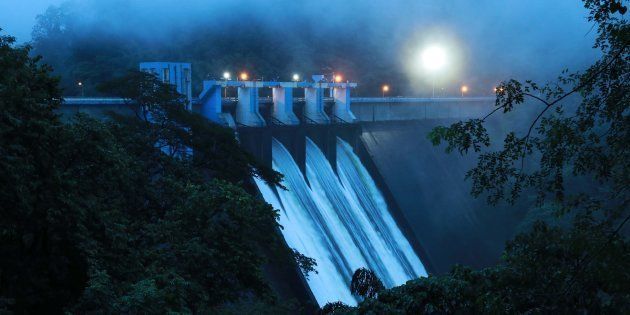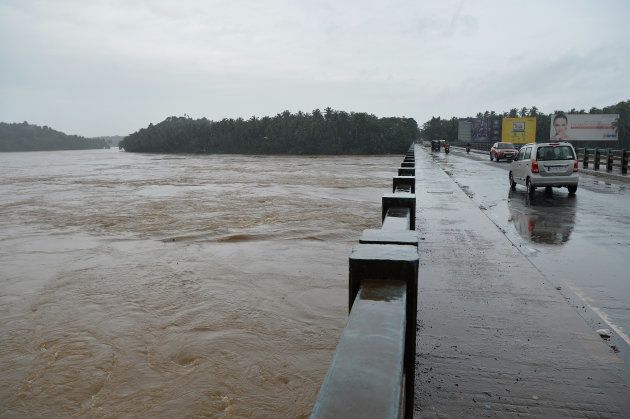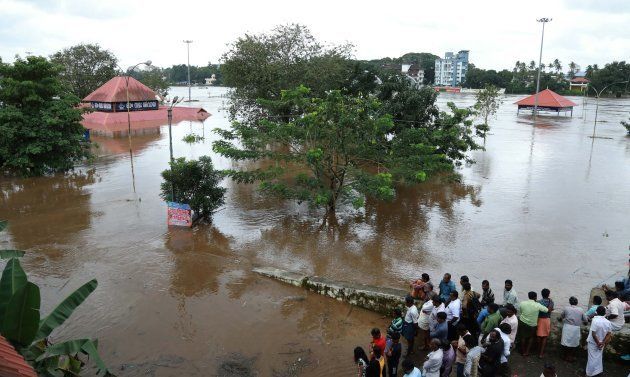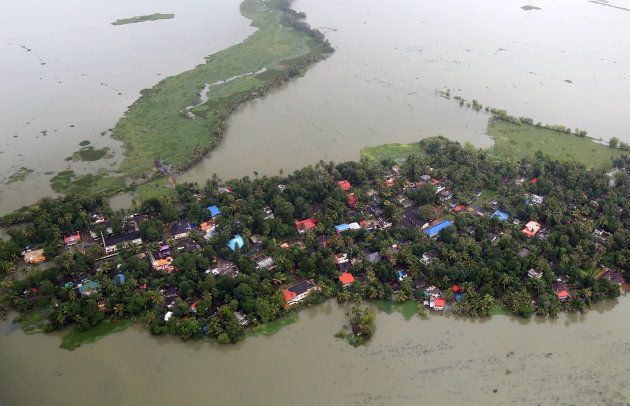
Kottayam, KERALA — As the rains lashed down without respite, Devaki from Champakulam, who lives by the backwaters in Alappuzha, awoke one night to find that the water had risen as high as her bed.
"They said something about opening the Kakki dam and the Idukki dam," she said, recalling how she swam out of her house to the seek refuge on the closest boat. "But why did they open them all? It felt like the whole river came in."
The Kerala government's decision to open the sluice gates of 33 dams in the midst of an unprecedented flood has attracted much debate. Critics have argued that the unplanned release of million of litres of water from dam reservoirs exacerbated the flood, which has claimed at least 350 lives and washed away homes and infrastructure that took decades to build.
Kerala State Electricity Board (KSEB) engineers insist that they did all they could in the context of a 1-in-1,000 year inundation, in which the state received 42% more rainfall than normal, with districts such as Idukki receiving 92% more rain as compared with long-term averages over the same period.
Lost in this debate is the fact that the fundamental assumptions for safe operation of India's dams are no longer valid. Climate change means a 1-in-1,000 year inundation may occur more frequently than previously assumed; deforestation of upstream and downstream areas have reduced the carrying capacity of rivers — making it more likely that rivers will overflow their banks; while urbanisation has meant floods now have more devastating effects.
India has 4,877 completed large dams, the third largest number in the world after the United States and China, suggesting that it is crucial that policymakers, disaster management officials, and dam engineers learn from the devastation in Kerala.

New Rules
A recent paper, presented at the Third National Dam Safety Conference in 2017, noted that most of these dams are over 20 years old, and "the original estimate of design floods was based on the scarcely observed flood records or on record of extreme rainfall events at that time".
The paper, by BRK Pillai of the Ministry of Water Resources, and OP Gupta, former Director of the Central Water Commission, used an updated methodology to find that most existing large dam projects in India, Kerala included, underestimated a critical safety parameter called Probable Maximum Flood (PMF), defined as the largest flood expected to occur in a particular river system, given the most severe weather conditions.
The study looked at 17 dam systems in Kerala and found they underestimated PMF by between 18% and 388%. This did not necessarily mean the dams were unsafe, the study noted, but pointed to the need to update risk reduction and mitigation measures to reduce risk to acceptable levels.
"How should we plan for a 1/1000 year event which nobody had predicted when our catchment to dam travel time is just 3-4 hours?" asked James Wilson, special officer of the inter-state advisory committee of the Kerala government. "People don't know how reservoirs have saved Kerala from the floods, by absorbing intensity, however small it is, the question to be asked here is whether any dams let out more inflows than they received during the peak of flood or absorbed it? If rains have failed in the dry months, aren't we supposed to keep some water aside?"
How should we plan for a 1/1000 year event which nobody had predicted when our catchment to dam travel time is just 3-4 hours?
That reservoirs can contain floods, if operated right, isn't disputed; India's National Water Policy recommends the provision of an adequate flood cushion but also states that flood control be given overriding priority in reservoir regulation policy.
Flood guidelines prepared by the National Disaster Management Authority in 2008 warn that if reservoirs are filled at the beginning of the monsoon to meet water, power or irrigation demands, a large quantity of water may suddenly have to be released to ensure the dams don't burst.
"The inability on the part of the agency in charge of operating the reservoir to anticipate intense rainfall in the catchment, and consequent large inflows into the reservoir, may also necessitate the release of a large quantity of water resulting in large-scale flooding," the guidelines say.
Events in Kerala bear this out.

Rising Levels
On 1 June, at the start of the monsoon, the Idukki and the Pamba reservoirs were already 25% full.
By 17 July, storage at the Idukki and Sholayar reservoirs was at 72%.
S Unnikrishnan and his colleagues at the Chalakudy River Protection Forum had been monitoring rising levels in the Poringalkuthu reservoir for a week. On 5 August, he wrote to the district collectors of Thrissur and Ernakulam, the ministers of power, water resources and local self-government, as well as all municipalities in the Thrissur region, urging them to take note of rising capacity in the reservoirs and an imminent risk of floods.
In another letter on 10 August, the Forum asked the Joint Water Regulatory Board to notify dam authorities to ensure controlled release at this stage to ensure an adequate flood cushion. They received no response, Chalakudy town received no flood or evacuation alerts and the reservoirs reached their full capacities.
"They had enough time and warning to do the right thing. With the South–West monsoon still active and the North–East monsoon to follow, immediate measures should have been taken to ensure that the reservoirs have sufficient storage space to absorb possible inflows in the event of high to very heavy rainfall, for the remaining period of this monsoon," says Unnikrishnan. "No matter how many dams you have, all of the water comes to the river, so what we need is a river basin-based approach, rather than individual dams, with a cumulative impact assessment and flood mapping."
One of the key issues that the flood has brought up is the lack of flood monitoring.

Forecast Fiasco
The Central Water Commission (CWC) — responsible for flood forecasting — has no flood forecasting stations in Kerala's river basins or in 14 other states. This is despite announcing in December 2015 that two would be set up in Kerala. The rain gauges it does have in Kerala, says Unnikrishnan, are in far from useful locations — for instance, CWC's rain gauge lies 35 km downstream of the Perambikulam dam.
"Even so, what flood forecasting system does Kerala have? Why does CWC or state government have no flood forecasting system?" asks Himanshu Thakkar of the South Asian Network on Dams, Rivers & People. A government audit of the state's dam safety measures, reported first in Down To Earth, found that none of the state's dams had Emergency Action Plans. "They are not supposed to fill up the dam till the end of the monsoon. On 31 July, authorities had tested the opening of the gates of the Idukki dam, and then decided against opening it. You had a window to really do that and can't only blame Mullaperiyar and Tamil Nadu."
What flood forecasting system does Kerala have? Why does CWC or state government have no flood forecasting system?
Wilson disagrees. "Flood monitoring as is might work in the Sardar Sarovar or the Mettur dam, with large catchment areas, but not in the context of Kerala, with its unique topography, rainfall patterns, reservoir capacity and population density," he says. "It takes 2.5-3 hours for water to reach Idukki. This is decision-making that has to be made within 5 minutes, and engineers have done it, despite never having seen an extreme rainfall event."
Kerala electricity authorities, including dam safety officials who did not want to be named, say their hands are tied by energy, irrigation and water needs.
"We preserve water there, because if monsoon fails, all of Kerala is in the dark. Last year was a drought year — what if the IMD predictions are wrong and the monsoon fails?" contends Wilson.
As of last year, KSEB's hydel power projects contributed to nearly 70% of the state's installed power capacity. Once a power-surplus state, vagaries in rainfall could be used to justify a power crisis and signal a slow shift to fossil-fuel projects, counter-productive to climate change mitigation efforts.
"Society has to take a call — should we make room for more flood space — disturbing ecology by submerging more forests in the catchment areas — or are we ready to make a compromise on our meagre storages needed for multipurpose use during lean periods?" Wilson said. "Everybody has to come together — climatologists, hydrologists, ecologists, disaster experts and sociologists — to take these decisions, after people have left the relief camps."
Society has to take a call — should we make room for more flood space — disturbing ecology by submerging more forests in the catchment areas — or are we ready to make a compromise on our meagre storages needed for multipurpose use during lean periods?
In the wake of the floods, M Rajeevan, the secretary for earth sciences, pronounced reservoir decision-making in the country to be "unscientific" in the wake of the floods. The lack of faith in weather predictions issued by the India Meteorological Department — under his ministry's command — is just as disturbing.
"Not all heavy rainfall events have the same effect — for example, if your dams are overflowing, you need impact-specific weather advisories highlighting the severity," observed Akshay Deoras, a Nagpur-based meteorologist. "But most forecasts keep using words like heavy rainfall, scattered rainfall, isolated places — what does that even mean? People don't know, the media won't care. Either forecasters change their vocabulary or fatalities won't stop."
Either forecasters change their vocabulary or fatalities won't stop
With the impact of climate change most deeply felt in the South Asia region, a 1/1000 event can no longer be ruled out, but should be the new norm. The Intergovernmental Panel on Climate Change, in its Fifth Assessment report, observed that there has been an overall decrease in seasonal mean rainfall in the monsoon, with more break days, but an increase in extreme rainfall events. However, all of their models and scenarios project an increase in extreme precipitation in the Indian summer monsoon.
Given that more dams are being planned and cleared by the Indian environment ministry, lessons from the floods are pertinent for all states, from Maharashtra, with the most number of dams, as well as the North-East and dams in Central India that see cyclonic rainfall.
What India — not just Kerala — needs right now is more accurate and real-time flood forecasting, weather forecasts and climate models that look ahead, protection of natural flood buffers, better communication and investment in science and technology that can save lives.
The people of Kerala are resilient — a factor that has saved more lives than probably anything else — but doesn't make the loss they're coming to terms with this week any less acute. The floods have tested them, as will climate change.
Devaki, whose village is at huge risk from sea level rise and already sees periodic floods, is shaken and doesn't know when she can go back home. "I'm from Alappuzha — we are not scared of waist-deep water. But today, I don't know if I can bear to look at the river or the rain the same way again."